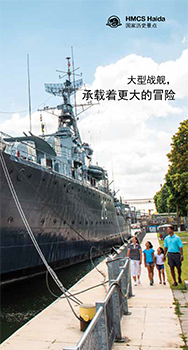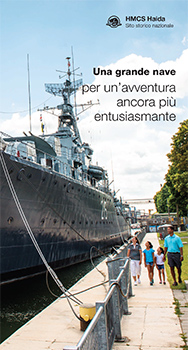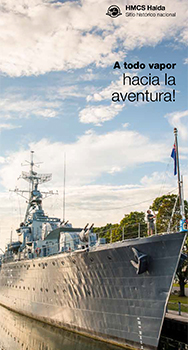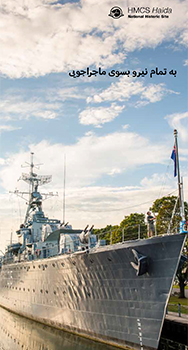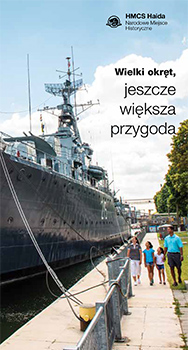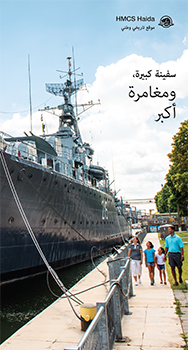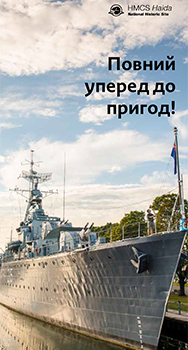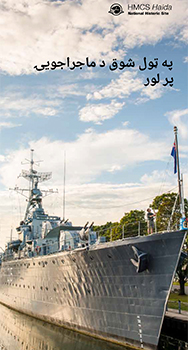Visitor guide
HMCS Haida National Historic Site
Full Steam Ahead to Adventure!
Download the guide in 简体中文, Italiano, українська, Español, فارسى, Polski, پښتو or العربية below!
Welcome to HMCS Haida
Download the HMCS Haida National Historic Site visitor guide, (PDF, 900 Kb)
Safety first
- Face all ladders going up and down
- Walk with care as there are many obstacles
- Decks are slippery when wet
- Be mindful of low clearance overhead
Please follow the arrows and numbers to see all of our exhibits and displays.
Self-guided tour

- Brow
Check in and drop off your station card here. - Torpedo tubes
The only remaining armament from 1943, the four torpedoes would rotate and fire over either side of the ship. - Twin 4" high angle guns
These anti-aircraft guns could hit targets up to 15 km away (the distance from here to the Hamilton Airport). - Petty officer's mess
About 20 Petty Officers, who supervised trade crews, lived here. It now houses a display of the ship’s career. - Chief's flats
The senior tradesmen quarters. - Operations room
The ship’s information centre, which housed sonar and radar, navigation, and the wheelhouse for steering. Ask staff for access. - Captain's sea cabin
The Captain ate and slept here when at sea. - Bridge
The ship’s command centre — weapons firing, navigation, and communication was directed from here. - Signal flag deck
Alphabetical and numerical flags and pennants were hoisted to relay messages to other ships or shore. - Catwalks
An October 1944 addition to make it safer to move around the ship. - 40mm boffins
These anti-aircraft guns from 1949 could be used to fire at low angle targets in the water. - Emergency steering position
One of four different places to steer the ship, used when the wheel house was out of operation. - 3”50 anti-aircraft and surface weapon
This radar-controlled automatic gun, installed by 1951, could fire up to 80 rounds per minute. - Squid anti-submarine mortar
The ship’s antisubmarine weapon, installed by 1951. The ship used depth charges previously. - Squid handling room
The elevator shaft in the middle of the room lifted mortar bombs from the magazine two decks below. - Wardroom flats
Compare these luxurious living conditions for officers to those for lower ranking sailors. - Captain's day cabin
The Captain’s quarters, complete with a private bathroom and office. - Sick bay
The ship’s hospital or infirmary, overseen by the ship’s medical artificer. - Engineering office and cabin, KVA and Radio 2
Where the chief engineer worked and slept, the ship’s power generator, and a back up radio room. - Engine Room
Two steam-powered turbine engines could reach speeds of 36.5 knots or 67 km/h. - Damage control office
Permission to open hatches leading to the lower decks was granted from here. - Main galley
Three or four cooks worked here to prepare meals for over 200 men. - Transmitting station
Here data was fed into the Admiralty Fire Control Clock to aim the guns. - Mess decks
The living quarters for the ship’s company, where over 200 men would eat, sleep and relax. - Radio 1
The main communication centre, where messages were decoded and sent to its recipient.
Explore HMCS Haida
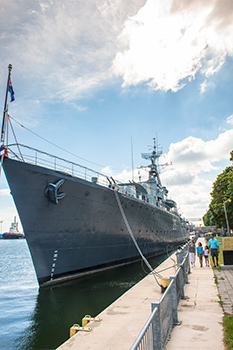
His Majesty’s Canadian Ship Haida, the last of 27 Tribal-class destroyers in the world, was commissioned in 1943 by the Royal Canadian Navy during the Second World War. The ship’s career spanned twenty years, including the Second World War, the Cold War, and the Korean War.
From 1943 to 1945, during the Second World War, HMCS Haida sunk or damaged more enemy surface tonnage than any other Canadian ship to this day. The ship earned battle honours for its service in the Arctic, the English Channel, the invasion of Normandy, and the Bay of Biscay.
From 1952 to 1954, HMCS Haida patrolled Korean waters during the Korean War and afterwards. Awarded a fifth battle honour, HMCS Haida joined the Trainbusters Club, an exclusive club of UN ships. To join, a ship had to destroy the locomotive and all of the supply wagons of an enemy train; HMCS Haida destroyed 2.5 trains. Following the Korean War, the ship joined the RCN’s anti-submarine fleet, where it remained until retirement.
When HMCS Haida was decommissioned in 1963, the ship was saved from the scrap yard by HAIDA Inc. - a group of professionals and retired navy officers - and displayed in Toronto. In 2003, the ship was acquired by Parks Canada and moved to its home in Hamilton, Ontario.
During your visit today
The crew gave up much by serving aboard HMCS Haida. Crew members sacrificed the comforts of home, did not see friends and family for long periods of time, and risked their lives in combat. Can you imagine calling HMCS Haida your home for weeks at a time? Ask our staff and volunteers about the experience of the sailors who served aboard the ship.
Life aboard

HMCS Haida’s crew came from across Canada. Men joined for countless reasons: some men, like the officers, were career professionals assigned to the ship; many volunteered to serve their country; others enlisted because the navy offered good opportunities. The crew was young and eager to prove themselves. In the Second World War, the average age of a sailor was 21; the oldest was in his 40s.
Life onboard was characterized by isolation and comradery. The ship could be at sea for days, weeks, or months at a time. A sailor might wait weeks for a letter or months for leave to visit home. Strong bonds were built among the crew, living and working together day in and day out.
For the crew, there was always a risk they may not make it home. The water and weather loomed over life onboard - the pitch of the sea could send sailors flying, causing injury. Combat could come at any moment, lasting hours. HMCS Haida lost two men in total during the ship’s naval career, when a gun exploded.
Sailors, supplies and equipment stuffed HMCS Haida. The crew numbered between 225 to 245 men: the captain and 14 other officers, sailors, stokers, mechanics, sparkers (radio operators), signallers, coders, cooks, stewards, and other specialists. The ship operated 24 hours a day – sailors had to feed the boilers, receive communications, polish brass, cook meals, practice drills, and complete countless other tasks to keep the ship and crew in top form.
Other languages
- Date modified :
